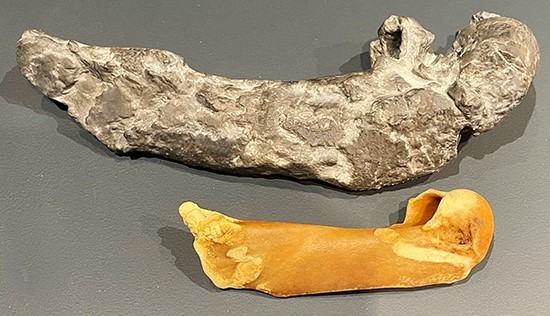New Zealand has been a haven for
earthbound birds for eons. The absence of terrestrial predators allowed
flightless parrots, kiwis, and moas to thrive. Now researchers are adding two
prehistoric penguins to this grounded aviary. One species is a beefy behemoth
that waddled along the New Zealand coastline nearly 60 million years ago. At
almost 160kg, it weighed as much as an adult gorilla and is the heaviest
penguin known to science.
اضافة اعلان
Alan Tennyson, a paleontologist at Museum
of New Zealand Te Papa Tongarewa, discovered the supersize seabird’s bones in
2017. They were deposited on a beach known for large, cannonball-shaped
concretions called the Moeraki Boulders. The churn of the tide cracked open
several of these 57-million-year-old boulders, revealing bits of fossilized
bones inside.
 A
cast of Kumimanu’s humerus (left), created from 3D scans, alongside a humerus
of an emperor penguin.
A
cast of Kumimanu’s humerus (left), created from 3D scans, alongside a humerus
of an emperor penguin.
Tennyson and his colleagues identified the
fossilized remains of two large penguins. The humerus of one, at more than 24cm
long, was nearly twice the size of those found in emperor penguins, the largest
living penguin. Other boulders yielded bones from a smaller, more complete
penguin species that also appeared to be larger than a modern emperor penguin.
The researchers described the ancient birds
last Wednesday in the Journal of Paleontology. They named the larger penguin
Kumimanu (a mashup of the Maori words for “monster” and “bird”) fordycei and
named the smaller penguin Petradyptes (“rock diver”) stonehousei.
By creating 3D models of Kumimanu’s
humongous humerus and comparing its size and shape with the flipper bones of
prehistoric and modern penguins, the researchers estimate that the “monster
bird” weighed a whopping 154kg.
The churn of the tide cracked open several of these 57-million-year-old boulders, revealing bits of fossilized bones inside.
According to Daniel Ksepka, a
paleontologist at the Bruce Museum in Greenwich, Connecticut, and an author of
the new study, the Kumimanu’s fragmented skeleton makes it difficult to
pinpoint its height. Ksepka estimates that it stood around 157cm, giving it a
stocky build. Petradyptes was not a lightweight, either. It weighed 50kg,
making it heftier than modern emperor penguins, which top out at 40kg.
Prehistoric diversBoth Kumimanu and Petradyptes plied the
waters off New Zealand during a sweet spot in oceanic history, according to
Ksepka. The asteroid impact that ended the dinosaur era had wiped out most
marine reptiles while the ancestors of seals and whales were still on land.
This meant there were few things that would mess with a black-bear-size
penguin.
“If you’re a little 1-pound (0.45kg)
penguin, a gull can just rip your head off,” Ksepka said. “But a 300-pound
(136-kg) penguin is not going to worry about a sea gull landing near it because
it would just crush it.”
Despite their prodigious size, Kumimanu and
Petradyptes possessed primitive flippers reminiscent of modern seabirds like
auks and puffins that fly and dive. Julia Clarke, a paleontologist at the
University of Texas at Austin who studies the evolution of diving in birds and
was not involved in the new study, said it would make sense for early penguins
like Kumimanu and Petradyptes to retain several features left over from their
ancestors’ airborne lifestyle.
The new species add evidence that prehistoric penguins became huge before they fine-tuned their flippers into paddle-like appendages.
The new species add evidence that
prehistoric penguins became huge before they fine-tuned their flippers into
paddle-like appendages. Heavier seabirds are able to dive deeper and longer
than their lighter counterparts, Ksepka said. The extra paunch would also have
helped these penguins stay warm in the water.
While Kumimanu was mighty, it did not crowd
out its smaller penguin cousins. “You have super large penguins eating the
largest prey items and you also have mid-sized and smaller-bodied penguins, and
they can all specialize within a crowded penguin environment,” Clarke said.
Big, big birdsDespite plenty of seafood and little
competition, these penguins could probably grow only so big.
“I believe that Kumimanu is close to the
upper limit of a flightless seabird and I do not expect substantially larger
penguins to be found,” said Gerald Mayr, a paleontologist at the Senckenberg
Research Institute in Frankfurt, Germany, who described the closely related
100-kg Kumimanu biceae. Mayr, who was not involved in the new study, notes that
heavier birds would most likely crush their eggs into yolky smithereens.
As some of the earliest fossil penguins,
Kumimanu and Petradyptes reveal just how quickly penguins packed on pounds
after they stopped taking to the skies.
“Once you know you’re not flying anymore,”
Ksepka said, “the sky’s the limit.”
Read more Odd and Bizarre
Jordan News







